In New York, you have the right to file a medical malpractice case if you have been harmed by a medical professional's negligence. However, that right doesn't last forever. New York statute of limitations laws limits the amount of time you have to take legal action against a medical provider.
Our New York medical malpractice attorneys want you to understand the law so we can better protect your rights. Learn some important information that any victim of medical negligence should know.
What Is the Statute of Limitations?
The statute of limitations for NY medical malpractice is the term for state-imposed time limits on how long you have to file a lawsuit. If you fail to take legal action before the deadline for medical malpractice set by the New York Unified Court System, state courts will not hear your case.
An experienced medical malpractice lawyer is familiar with the New York medical malpractice statute of limitations and will ensure your claim is filed before the deadline.

What Is the Statute of Limitations on Medical Malpractice in NY?
In most cases, the deadline for medical malpractice lawsuits is 30 months from the date of the alleged malpractice or the end of continuous treatment. The New York medical malpractice time limit aims to protect healthcare professionals from the threat of malpractice claims long after medical services were rendered.
At the same time, the medical malpractice statute of limitations in NY is long enough that an injured patient has a reasonable amount of time before the limitations clock runs out. Two and a half years is typically enough time to decide whether to pursue a malpractice suit.
The Discovery Rule
Sometimes, injured patients couldn't possibly have been aware of negligence by healthcare professionals within the time granted by New York medical malpractice laws. The New York medical malpractice statute of limitations discovery rule extends how long these patients have to file malpractice suits. However, New York laws significantly limit the circumstances in which the discovery rule can be applied to extend the time limit on filing malpractice claims.
The New York discovery rule applies only to cases involving cancer or a foreign object left inside a patient's body. The rules for these limited situations extend the statute of limitations in the following ways:
- If a medical provider leaves any type of foreign object inside a patient, the time limit for a medical malpractice claim doesn't start until either the foreign object is discovered or information is learned that would reasonably lead to the discovery of that foreign object. Once that occurs, the malpractice statute of limitations gives the patient one year to act.
- When a medical professional fails to correctly diagnose cancer, the clock doesn't start until ongoing treatment ends or the patient learns about the diagnostic error.
While limited, this rule can significantly extend the statute of limitations.
Medical Malpractice Statute of Limitations Exceptions in New York
While the typical statute of limitations for medical malpractice is 30 months, the time limit for medical malpractice claims can be either extended or reduced in specific circumstances. New York medical malpractice attorneys can help you determine when these circumstances apply.
Can the Statute of Limitations Be Extended for Continuous Treatment?

The continuous treatment doctrine states that the New York malpractice statute of limitations is extended while you are receiving ongoing treatment. At the conclusion of that treatment, whether you are cured or not, the 30-month clock starts for you to file a malpractice claim for medical negligence.
The reason for the extension is that a patient might receive less effective treatment if they have an active medical malpractice case against the doctor who is treating them.
Insanity
If a patient is determined to be legally insane, the statute of limitations is extended while they are disabled. If their condition improves, the time limit resumes with whatever time was remaining when it was paused. However, the statute of limitations can't be paused for more than 10 years, according to the New York statute.
Wrongful Death
Typically, the statute of limitations for a wrongful death claim is shorter than the usual time limitations in New York for medical malpractice. If you believe a loved one died due to medical negligence, you have two years from the date of death to file a wrongful death lawsuit.
However, a wrongful death lawsuit isn't your only option if a loved one has died due to medical negligence. You also have the right to make medical malpractice claims against negligent medical professionals to cover the cost of any treatments they gave the deceased before they died.
This type of claim must be made on behalf of the estate, and the statute of limitations can be extended if any other relevant guidelines applied while the patient was alive.
Discovery of Foreign Objects Inside of the Body
The discovery rule delays the start of the statute of limitations clock for taking action against alleged malpractice. The patient has only one year to file a malpractice claim, but that time limit doesn't start with the negligent act. Instead, it starts when the medical error is discovered or should reasonably be discovered.
Unlike the extension of the statute of limitations for medical malpractice due to insanity, this extension has no maximum. If the medical error isn't discovered for decades, the patient retains the right to make a malpractice claim.
Medical Malpractice Against Minor Children

When the patient who has suffered due to medical malpractice is a child, the statute of limitations is greatly extended. In New York, medical malpractice claims for minor children have a deadline of either 10 years after the patient is injured or 30 months after the injured patient turns 18, whichever comes first.
Additionally, this extension of the time limits to file a malpractice claim can combine with other extensions. Thus, if a foreign object left inside a child was discovered at age 12, the rule regarding minor children would take precedence over the normal one-year deadline for a malpractice claim.
Claims Against Municipal Hospitals
The medical malpractice statute of limitations is severely reduced when filing a claim against a municipal hospital in New York state. A municipal hospital is a city, county, town, or village hospital. These hospitals are typically operated by organizations like Nassau University Medical Center or the New York City Health and Hospitals Corporation (NYCHHC). New York state statute requires that lawsuits against municipal hospitals are brought within 15 months of the alleged malpractice.
NYCHHC is further protected. The patient must file a Notice of Claim against that hospital system within 90 days of any malpractice, regardless of when the lawsuit is filed. If the Notice of Claim isn't filed in that time frame, other time limits may not matter. Judges have the discretion to excuse a late Notice of Claim, but this action is uncommon.
Claims Against Federally Funded Hospitals
The New York state medical malpractice statute of limitations doesn't apply to medical malpractice lawsuits against federally funded hospitals, clinics, or physicians, even if they operate in New York. Medical malpractice lawsuits against these entities must be filed in federal court, which means that federal statute of limitations laws apply.
The federal statute of limitations for medical malpractice is two years from the discovery of the malpractice and does not include exceptions for infants, cancer, or foreign objects. Even a medical malpractice attorney might be caught off guard if they assume New York law applies when it does not.
If you have any reason to believe you have suffered from malpractice, you should contact a medical malpractice lawyer immediately to give them time to determine whether federal or New York law is applicable.
Claims Against New York State Hospitals
There are additional time limitations for medical malpractice claims made against New York state hospitals. Malpractice cases must be filed within two years of the negligent act and can only be filed in the New York Court of Claims. All cases tried in this court are decided by a judge rather than a jury.
Furthermore, before you pursue a case against a state hospital, you must file a Notice of Intention to File a Claim with the attorney general no more than 90 days after the malpractice occurred. This is similar to the rule for municipal hospitals, although it includes exceptions for infants who were harmed by malpractice.
Finally, this statute does not protect individual medical practitioners, who fall under normal rules even if they work in a state hospital.
Cancer Misdiagnosis

When a medical practitioner has failed to properly diagnose cancer in a patient, Lavern's Law extends the statute of limitations for medical malpractice. While most malpractice claims must be started within 30 months of the medical error, this law allows the medical malpractice case to be filed within 30 months of the discovery of the malpractice.
However, there are limitations to Lavern's Law. First, this law only applies in cases involving misdiagnosed cancer. Additionally, the medical malpractice case must be brought within seven years of the original act, no matter when the misdiagnosis was discovered.
Lavern's Law also doesn't change the rules for making claims against municipal or state hospitals, except that the trigger for deadlines switches from the act of malpractice to the discovery of it.
What Happens When You Miss the Deadline for Medical Malpractice Statute of Limitations?
When you miss the deadline for the statute of limitations on medical malpractice in New York, you are typically barred from filing your claim with New York courts.
Certain circumstances allow for exceptions. But if you don't qualify for an exception, the courts usually don't have the authority to extend the deadline.
What Are the Benefits of Starting Your Medical Malpractice Claim as Early as Possible?
The sooner you start your malpractice claim, the more likely you are to receive the compensation you deserve for two reasons:
- Evidence: Evidence disappears over time. The longer you wait to file your claim, the harder your medical malpractice lawyer will find it to prove your case.
- Ongoing Support: You can potentially start receiving compensation for ongoing medical treatment while your claim is active. But you can only receive that compensation if you have started your lawsuit.
At a minimum, you should speak to a lawyer as soon as possible.
Jacob Fuchsberg Law Firm Is Ready to Help You Right Now!
The last thing you need after suffering from malpractice is to run afoul of the statute of limitations. Medical malpractice in New York is complex, but the attorneys at the Jacob D. Fuchsberg Law Firm are always ready to help you navigate it.
If you want to know more about how the New York medical malpractice statute of limitations affects your malpractice claim, call us today at (212) 869-3500 or contact us online for a free consultation.
FAQ
Don't Let Time Run Out on Your Rights
Contact Jacob D. Fuchsberg Law Firm's experienced NY medical malpractice attorneys today for a free consultation. We'll evaluate your case and ensure you meet all critical deadlines.

.svg)











